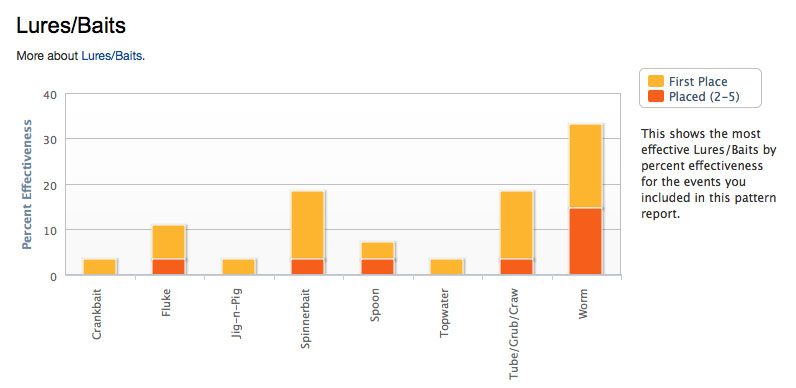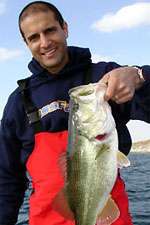
With Elite Series pros hitting the St. Johns River this week, Ken Cook and I previewed the tournament using historical data in BassGold.com.
Though BassGold nailed the winning pattern and weight at the recent Red River Bassmaster Classic, we can’t say yet whether it’ll be as good a forecasting tool this time. But one thing is for sure: Data doesn’t lie. So here’s a quick look at what the BassGold information tells us when we generate a “Pattern Report” for the St. Johns in the spring.
Macro Factors
In BassGold, the “Macro Factors” show generally where on a body of water a tournament has been won or “placed” (2nd through 5th). Looking at the Macro Factors bar graph, it’s no surprise that for tournaments held during this time of year, “Shoreline” accounts for nearly half of 1st through 5th finishes.
“River” also figures high in wins, but not as much in 2nd through 5th finishes. In this case, “River” can be a companion to “Shoreline” and can also mean drops, which we’ll take a look at in the next category.
Habitat Factors
“Habitat Factors” are cover and structure types. In this case, “Submergent Veg” – meaning vegetation below the surface of the water – is the top category (highest bar on the graph) in St. Johns spring tournaments, with “Spawning Beds” second.
The Habitat Factors graph tell us that only a few tournaments in the BassGold database have been won on a main-river “Ledge/Drop,” so without yet looking at the details of each pattern, it seems that the “River” Macro Factor also goes with “Shoreline.” In other words, anglers on main-river shorelines have done well in the past – not exclusively main-river shorelines, just mostly.
Lures/Baits
“Lures/Baits” is the name of the third category of bar graph, and in this case – again, no surprise – soft-plastics are the deal. The “Worm” category is tops, with almost a third of all 1st through 5th finishes, and “Tube/Grub/Craw” and “Spinnerbait” are tied for second.
Cook said: “Weather is the key to fishing patterns for the St. Johns. Cold fronts make everything change, so I have to bet on slow moving baits around ‘sub veg’ in a spawning area like a bay.” In other words, exactly what the BassGold data indicates.

Daily Weight
The fourth graph on a Pattern Report is a plot of winning and placing weights by month. The Red River Pattern Report showed about 17 pounds per day needed to win or around 51 pounds total – and Chris Lane won with 51-06. This time it looks like a little more than that, maybe 17 1/2 pounds per day on average.
Whatever the winning weight turns out to be, it will go into the database and help to inform future “gold” mining.
More Gold
While part of the “gold” in BassGold is the data itself – the display of that data and having decades of pattern details right at your fingertips – there’s more gold to be mined in how you interpret the data using your fishing knowledge and experience.
Two quick examples:
- The first spring B.A.S.S. tournament on the St. Johns was in early February 1973 and was won by fishing Rodman channel eelgrass with a Big-O crankbait.
- Ken Cook won the March 1983 Super Bass tournament fishing main river eelgrass with a spinnerbait.
Is that information valuable? You bet. “You just have to read between the lines,” Cook said. For example, “The early leaders of the Super Bass in 1983 were bed fishing, but fell on their collective noses when the cold front came through.”
He added, “One trap anglers fall into with this information is looking for the obvious, then trying to find something odd that no one else will be doing. Sometimes that works spectacularly – that’s how I won the Super Bass in 1983 – but it can fail miserably, too.
“I encourage anglers to use BassGold to find the most likely winning patterns, and work hardest on them. Then, if you have that figured out, look for something else.”
When you give BassGold a try, if you don’t see your favorite lake in there yet, remember that BassGold is also set up to be the world’s best fishing log. Upload your own patterns or patterns from a newspaper or website – they don’t have to be from tournaments – and keep them private if you want.
Not only will this help you remember things you’d otherwise forget, but when you see your own pattern information displayed like the above graph, you’ll be surprised. You’ll find out that some of what you thought you knew really is true, and some isn’t.

